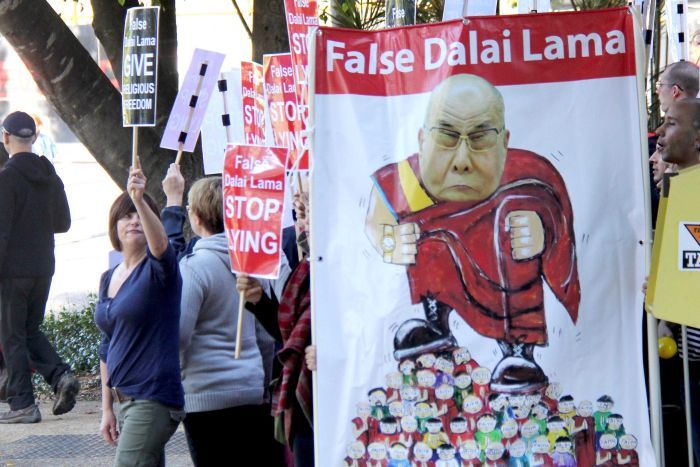By Bill Birtles (ABC): Updated Thu 11 Jun 2015:
A small but noisy group of Buddhist protesters have been picketing every stop of the Dalai Lama’s tour since he arrived in Sydney last week.
Shugden Buddhists worship Dorje Shugden, a prominent deity in the largest and most powerful order of Tibetan Buddhism known as Gelugpas.
Under the guide of the International Shudgen Community (ISC), some have accused the Dalai Lama of teaching Buddhists to exclude and marginalise Shugden worshippers within exiled Tibetan communities.
A small group of protesters gathered on Thursday morning in Brisbane, where the Dalai Lama was visiting as part of his national tour, carrying placards and chanting “stop lying, false Dalai Lama”.
Dorje Shugden is traced back to the 17th century and has been described as both a protector spirit and a fierce spirit, depending on interpretation.
Traditionally Gelugpas, including the Dalai Lama, worshipped Shugden along with other deities, but according to Tibetan history professor John Powers from the Australian National University, Shugden worship has long been associated with a history of division.
“Dorje Shugden is feared by other orders and is associated with sectarianism particularly among the Gelugpas,” Professor Powers said.
“So because he needed to build a harmonious community among Tibetan exiles, the Dalai Lama wanted to get rid of that practice.”
As a result, the Dalai Lama in the 1970s renounced the worship of Shugden, describing it “controversial and divisive”. In the 1990s he requested followers of Shugden not to attend his religious teachings.
David Templeman, a Tibetan history scholar at Monash University’s Asia Institute, said the request was very hard for many Shugden followers to comply with.
“They have a series of beliefs in a certain deity that they’ve been asked to renounce and for them that’s impossible according to the vows they’ve taken as practitioners,” he said.
“However there are many historical precedents for Tibetan Buddhists giving up vows for certain deities at certain times and there’s nothing to really prevent them except doggedness.”
Dr Templeman said the protesters emerged among followers of a particular Shugden Lama called Kelsang Gyatso, who moved to Britain in the 1970s and established a teaching school called the New Kadampa Tradition.
“I noticed he’s really stepped out of the picture and it’s really now up to his predominantly Western followers who have taken up his initial stance, which was a fairly understated one, and they’ve made something much bigger,” he said.
The ISC claims there are 2 million followers of Shugden in Tibet.
Dr Templemen believes the real figure is much lower, estimating it at around 100,000.
Professor Powers also believes it is much lower than the ISC estimate, but said claims that Shugden followers are “shunned” within Tibet are correct.
1 of”T2he Chinese government is putting up statues of Shugden in non-Shugden monasteries and forcing the non0-6S/h10u/g1d5e1n2:21 pm monasteries to accept them against their will,” he said.
“So there is a significant shunning of this practice by most Tibetans.”



